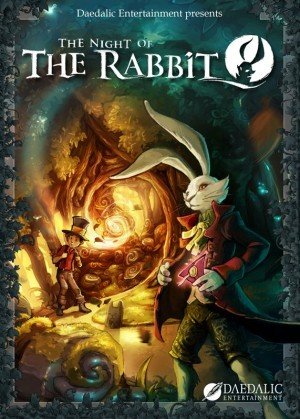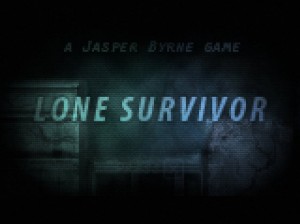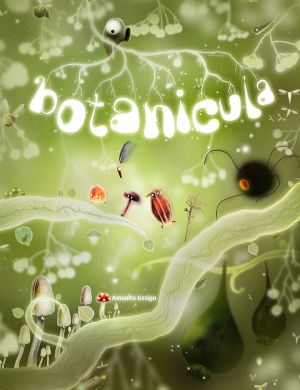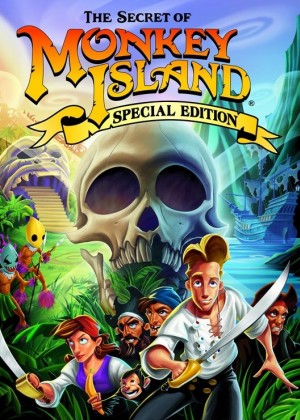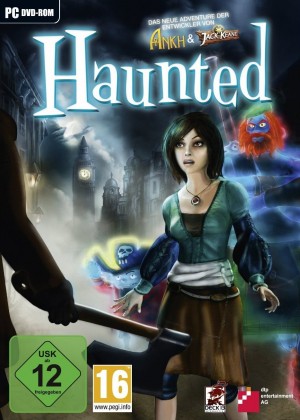The Night of the Rabbit - Daedalic’s Matt Kempke interview

Note: Since this article was originally posted, The Rabbit's Apprentice has been renamed to The Night of the Rabbit.
Daedalic Entertainment is no stranger to fantasy adventure, having already given us The Whispered World and The Dark Eye: Chains of Satinav. But soon the German studio will send players tumbling deeper down the rabbit hole, so to speak, in the role of The Rabbit's Apprentice, a collaboration with acclaimed indie designer Matthias Kempke.
The Rabbit's Apprentice stars little Jerry Hazelnut, a 12-year-old boy who longs to learn magic. With his summer holidays nearly at an end, Jerry's dream appears to come true when he meets the Marquis de Hoto, a magician willing to take him on as a student. But the Marquis is no ordinary wizard; he's a human-sized talking white rabbit who lives in a world where magic is very, very real. And dangerous. On the journey through his new mentor's home of Mousewood, a land filled with magical creatures and other talking animals, Jerry discovers that he was chosen to play a crucial role in confronting an evil force threatening to tear apart the fabric of reality. But to do so, he'll first need to overcome his greatest fear.
This modern day fairy tale promises many strange characters to interact with, gentle wit, unique puzzles, and a storyline that's whimsical enough to appeal to children, yet complex and philosophical enough to captivate adults as well. That sounds like Daedalic, all right, not to mention the game's formerly-independent project leader. Matt Kempke is the creator of the What Makes You Tick? series, a pair of similarly fanciful adventures with darker undertones set in gorgeous hand-drawn settings, a background that makes this partnership with Daedalic a natural fit for both sides. With production already well underway, we caught up with Matt to discuss the road that led to The Rabbit's Apprentice, and of course to learn more about the game itself.
Adventure Gamers: The White Rabbit in Wonderland, Harvey (both Edna's and Jimmy Stewart's), the Easter Bunny, even Max... What is it about rabbits that makes them so ideally suited as magical fantasy creatures? You just never hear of many anthropomorphic aardvarks.
Matt Kempke: Well, the Puca in the original Harvey is a creature that shows how impossible it is to draw a clear boundary between normal or insane – a creature that doesn't fit into a sane and scientific world. The White Rabbit in Alice in Wonderland is the one who crosses the border between here and Wonderland – and Alice follows.
And then there are magicians' rabbits. Where do those guys come from? What's their intention? And what's magical about them anyway? Are they to be trusted? When you write a game about magic, those are the questions you have to face at a certain point.
Our game about young Jerry Hazelnut and his rabbit teacher faces these questions – but just like in James Stewart's Harvey the answers are a bit more … complicated. And that's where our story gets interesting, I believe.
If aardvarks had such a rich past of imaginative depictions, maybe they'd end up in games and movies more often. We can only hope. I am pro-aardvark, by the way. (But only if that's a good thing.)
AG: The Marquis comes from a magical place called Mousewood. Is that a hidden land somewhere here on Earth, in another dimension, or a faraway different world entirely? (Or is this overthinking magic?)
Matt: That is a good question – we have all of them: hidden places, other dimensions and even a moth monastery. But back to your question: The Marquis is a special kind of magician, the kind who uses magic natural gateways between worlds (so called portal trees) to travel between different times, places and possibilities. Mousewood is one of those worlds. A place where mice and squirrels can talk and run restaurants and radio stations. The Marquis travels with Jerry to Mousewood because that's where he has trained students for ages. But the citizens of Mousewood don't know much about magic and, strangely enough, most of them don't remember the Marquis when he returns to Mousewood to train Jerry. Pretty mysterious, right?
AG: Very mysterious, I'd say. What's Mousewood itself like?
Matt: Mousewood is a bit like a human town or village might have been a hundred years ago, but since the inhabitants there are all mouse-sized, as is Jerry when he arrives there, their perspective on the world is a bit different from ours. Nature plays an important role in the game. Even magic stems from nature – at least in our story. There are several old portal trees hidden in the forests of Mousewood. Jerry has to find them and the magical creatures that cross back and forth between the worlds through the portals, in order to learn spells from them.
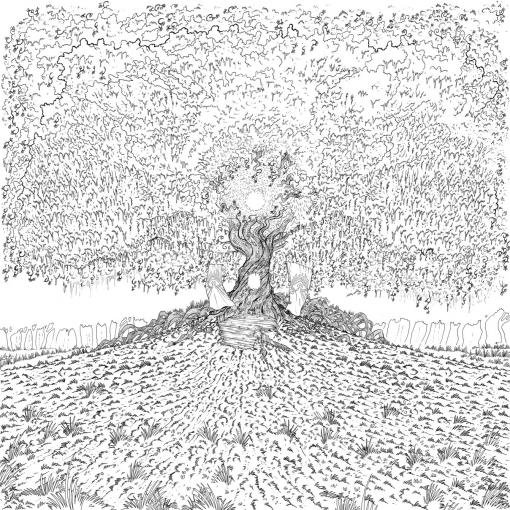
Exclusive concept art of a very "important" tree in The Rabbit's Apprentice.
AG: Does the bulk of the game take place in Mousewood, or is time split between there and the "real" world?
Matt: We will spend a good amount of time in Jerry's world, which could be yours or mine, then there's Mousewood, and then there's also other worlds beyond the portals of Mousewood, among them even the north pole, which Jerry visits during the game. But in the end he will have to venture beyond the borders of our reality to find out why he was chosen to be the Rabbit's Apprentice in the first place.
AG: Who are some of the other characters players will meet in Mousewood?
Matt: In Mousewood, players will very likely run into Plato the Frog, who's working as a mailman there, then there's Conrad the Owl and Jonathan Squirrel, who form the city council, and Anja Mouse from the tree stump café, an angry dwarf, a mysterious wood sprite and even more magical creatures like the Japanese fox girl Kitsune or the giant rock toad. But even the smallest guys in Mousewood like the city watch mice, the rabbit family, the radio host mole or the backpack mouse who don't know much about magic at all are pretty cool people. I know that, I've met them.
AG: What are some of the magic spells we'll learn in this game, and how will they be utilized? Will they work like de facto "inventory" items, or will spell-casting be a more involved process?
Matt: Well, the magic spells are pretty secret. So I definitely can't tell you about it. Really. Well, if you insist ... among the spells might be the ability to hear statues whisper about what they've seen … but then again, that could just be hearsay. The spells might be available in the inventory, but even if I spilled the beans here, where and from whom you learn them and when to use them is what makes them so interesting and mysterious. And later Jerry will have to use the spells he learned in a different way altogether, when he faces the Great Zaroff. Who is the Great Zaroff? Well, just head on to the next question to find out!
AG: Whoa, how did you know what I was going to ask next? You must be magic too! (Either that or you read my questions ahead of time.) But yes, here goes... Wherever there's magic, there always seems to be someone ready and willing to abuse it. What can you tell us about the "evil force" threatening to tear apart the fabric of reality?
Matt: The German title of our game is The Rabbit's Apprentice: Im Bann des Zaroff, which translates as “the Spell of Zaroff”, and you can even see his vile shadow on the box art. So yes, we have a villain who is named the Great Zaroff. And when someone is named after the scary master hunter from The Most Dangerous Game then it's pretty obvious that he really is up to no good. But WHO is Zaroff? How is he related to the story, Jerry and the Marquis de Hoto? That will be revealed in the game. Oh, and then there's the lizards, of course. The Consortium Squamata. They are pretty vile, too ...

AG: The human protagonist is 12-year-old Jerry Hazelnut. What do we know about him?
Matt: Jerry Hazelnut lives with his mother on the edge of a large city. He's really into magic and magicians and comic books and cartoons – and two days before the end of his summer holidays, Jerry runs into a well dressed man-sized rabbit with red eyes …
For now I can only say that them meeting is probably not a coincidence.
AG: Does he simply have an interest in magic tricks, or is his fascination with magic part of an escapist fantasy from his life?
Matt: It clearly is both. Jerry is not very keen on returning to school after the holidays. Probably because there he's given the stage name “The Great Nut”, as his magic tricks and his love for magic make him a bit of an underdog. And who of us wasn't? Magic is for Jerry what for some of us was science fiction or fantasy or for me Masters of the Universe or Star Trek. Yes, I suffered in school. But look where I'm now! Top of the world, Ma! Top of the world!
AG: Apparently Jerry will need to overcome his "greatest fear". I doubt you're ready to spill the beans as to what that entails (or are you?!), but are we talking about a crisis of faith of some kind, or a tangible, world-shattering, Stay-Puft Marshmallow Man kind of deal?
Matt: Jerry won't be able to blow up his greatest fear with a proton pack, because it is indeed a crisis of faith but also a real physical danger that he has to face. The game starts out with a promise and when that promise is broken, Jerry will have to face that “greatest fear”.
AG: A bit of Jerry in you? Or more the Marquis?
Matt: Well, a bit of both, I think. Jerry is naïve and open minded, while the Marquis is the adult who is able to make Jerry believe that he knows everything and is in control. Maybe you need a bit of the boy's view of the world to keep the Marquis in you in check, and a bit of the Marquis to make sense of the world's chaos with style.
In our story, the different views of the world – the boy's, the Marquis', Zaroff's – are the results of the characters' pasts and we will learn how each character's experiences and decisions shaped them. So, even the villains in the game are a part of me somehow, but which I hope to avoid. Especially the lizards … they are really vile.
AG: You're no stranger to the adventure scene, having previously designed the What Makes You Tick? series. Tell us a little about your background and how you came to be an adventure game developer.
Matt: At the end of the '90s I was still in school, and after I played The Curse of Monkey Island I was hooked. I loved the game's setting and mood, the music and the dialogue. The previous games were great too, but here the voice acting and the backgrounds just formed something very new and important for me. An artistic vision of a world coming to life in a fashion I had never seen before. I even made my own Monkey Island website that was hosted on mixnmojo. That's how I met my very, very good friend Greg MacWilliam, who had a Grim Fandango website there. The sites were swept away by the tides of time, but we kept in touch and met and travelled together.
Greg later created the wonderful LASSIE adventure game engine and I promised him to make a game with it – which then became What Makes You Tick? (freeware, 2007). Two years later we made WMYT: A Stitch in Time together, which Greg also produced and which was finished in 2010. It is a full length continuation of the story of WMYT. We both worked very hard for 1.5 years to finish the game. And though we are happy with the outcome, we both agreed never to do anything like that again because we wanted to stay alive and sane. I went back to university and Greg continued his job as a programmer and designer.
And then, in the fall of 2010, my brother Sebastian had an idea for a game … about a boy and a rabbit. And it started all over again. Just 5 months later and 4 months before my last exams at university, I went to the good people of Daedalic in Hamburg to pitch our game. One month after my last exam, I started working on the project.
Oh, and I almost forgot to tell you about this: in 2001, I mailed Jonathan Ackley who directed The Curse of Monkey Island to ask him how to get into the position to be able to make such fine games. And to my amazement he replied and told me in a pretty long and friendly mail that the best way is to make your own game and show it around. Without his kind and honest advice I might never have made any games at all. True story.
AG: Certainly can't argue with that advice. Since you took it to heart, what lessons learned from your previous games have helped you in making this one?
 |
What Makes You Tick: A Stitch in Time |
Matt: I learned how to write puzzle and dialogue scripts and how to plan backgrounds and such. During that creative process, it is very important to keep your doubts about your own work in check (although those doubts are a good thing for artists at times, I think). In such a case it helps a lot to be able to draw from past experiences. When you sit in front of a blank piece of paper to write puzzles, dialogue or to draw a background it can freak you out a lot, especially if you know that you need to be done in time. So believing in your own abilities helps – but it is also important to know when you might need help. For me, writing puzzles is something you need two brains for. For WMYT: A Stitch in Time I worked with Greg, and in the case of The Rabbit's Apprentice I worked with Ulrich Wanitschke, who was with Daedalic at the time. He was a really great co-writer for the puzzles.
AG: Who are some of your inspirations, either thematically or as a game designer?
Matt: For The Rabbit's Apprentice I'd say it's part Wind of the Willows, part Hayao Miyazaki, part Neil Gaiman and part Monkey Island. My brother came up with the initial idea of Jerry and the Marquis meeting and going through a portal tree … the Marquis was supposed to stare through Jerry's window the night before so the player should get an eerie feeling about this rabbit who takes the boy away. And it was my job to think about where the two go and why. And that's what The Rabbit's Apprentice is still about. So my brother Sebastian was a huge inspiration, too. But don't tell him.
AG: Your secret's safe with me (no promises for the thousands of people reading this). You've done quite a bit of world travelling yourself (though never as far as magical lands, as far as I know). Tell us about some of your real life adventures, and how those have influenced you and your games.
 |
Matt Kempke |
Matt: Well, with Greg I've hiked through the Swiss Alps, through Prague and went on a camping trip through the deserts and woods in the American West. I've been to Ireland and I always loved to do day trips with friends into the woods or old caved-in buildings at the edge of town. I love exploring and seeing something new or unexpected around the next corner, be it in a foreign place or just on the other side of town. This is what I love to do in games, too.
I studied Japanese Culture and Language and African Cultures, but I've never been there simply because when my mates at university went abroad, I was always working on a game. But still, what I've read and seen has influenced me a lot, too, and at some point I really need to go there.
AG: Daedalic's previous games have always had a nice blend of humour and whimsy with some surprisingly mature dramatic undertones. Would you characterize The Rabbit's Apprentice like that?
Matt: Well, the games that the talented Jan “Poki” Müller-Michaelis does have a very unique humour that I really like a lot. The Rabbit's Apprentice also has a lot of humour, but more like you've seen in my previous games. We also have dramatic undertones and hopefully you'll sob at one or two points – but also feel courage rising in yourself, as Jerry stands tall, and maybe you will also be scared or touched here and there. Our soundtrack by the wonderful Tilo Alpermann will, without doubt, help to convey these emotions, too.
AG: Your earlier games were purely indie titles. What convinced you that Daedalic was the right fit for this game as a partner/publisher, and how are the responsibilities on this game divided?
Matt: I approached Daedalic in the spring of 2011 and told them about our – me and my brother's – game idea. Since they are located in Hamburg, the place I was born and was aiming to live in, and I really like their games, I simply felt that it was my duty to try to go and talk to them. They were all really friendly and in the end the game went into production half a year later.
I am employed at Daedalic and am the creative lead for the project. That means that I get to work with many gifted people who help making the game.

AG: Would you classify The Rabbit's Apprentice as "old-school", or will you throw in some modern wrinkles to keep players on their toes?
Matt: The game is old school at heart, but I've tried to come up with some concepts that will make this game a bit more modern. For example, we simplified the controls for the game: the player can interact with characters or objects with just one click. In addition, we hid many collectable extras in the game. Also we got rid of some of the things I didn't like too much in old-school games … at one point in the game it should become pretty obvious what I think about sliding puzzles.
AG: What stage is the game at now, and when can we look forward to seeing it on store shelves?
Matt: We just recorded the voices for the German version and are in the beta-phase. The release for the German version is planned for November this year. An English version will probably be available sometime next year.
AG: Argh! The inevitable English language release delay... But this sounds like it will be worth the wait, and we certainly look forward to seeing more of The Rabbit's Apprentice in the coming months. Thanks for the early glimpse into the game, and good luck with the project.
Matt: Thank you very much and also thanks for your interesting questions. Keep up the good work! And also thanks to your readers for their endurance and patience with me if they've made it that far through the interview.
May the aardvarks live long and prosper! (… by now I'm sure that's a good thing!)



